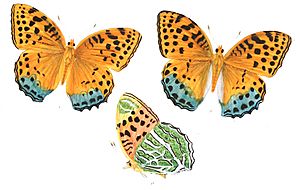John George Children facts for kids
Quick facts for kids
John George Children
FRS FRSE
|
|
|---|---|

Portrait, 1826
|
|
| Born | 18 May 1777 Ferox Hall, Tonbridge, Kent
|
| Died | 1 January 1852 (aged 74) Halstead, Kent
|
| Nationality | British |
| Alma mater | Queens' College, Cambridge |
| Spouse(s) |
|
| Relatives |
|
| Awards | Royal Institution Medal (1828) |
| Scientific career | |
| Fields | Chemist, mineralogist and zoologist |
| Institutions | British Museum |
John George Children (born May 18, 1777 – died January 1, 1852) was a talented British scientist. He was a chemist, who studies chemicals, a mineralogist, who studies minerals, and a zoologist, who studies animals. He invented a special way to get silver from ore (rock with metal in it) without using mercury, which can be dangerous.
John George Children was a good friend of Sir Humphry Davy, another famous scientist. He also helped start the Royal Entomological Society, a group that studies insects.
Contents
A Look at His Life
John George Children was born on May 18, 1777, in a place called Ferox Hall in Tonbridge, Kent. His father, George Children, was a banker and also a member of the Royal Society, a group for important scientists. Sadly, John George's mother passed away shortly after he was born.
He went to school at Tonbridge School, Eton College, and then Queens' College, Cambridge. In 1798, he married Hester Anna Holwell. After she died in 1800, he traveled a lot. He married Caroline Wise in 1809, but she also passed away the next year.
In 1815, he visited the famous battlefield of Waterloo. He bought a special tree there called the Waterloo Elm. This was the tree where the Duke of Wellington had set up his headquarters during the battle. John George had the wood from this tree made into beautiful furniture, including chairs that are now in royal collections. He passed away in Halstead Place in Kent.
His Scientific Adventures
John George Children and his friend Sir Humphry Davy did many experiments together. In 1813, John George built a very large galvanic cell, which is like a big battery. He used it to do experiments, and his findings were published in a science paper in 1815. For this work, he received a special medal in 1828.
In 1824, he found a new way to get silver out of ore without using mercury. This new method was so good that several mining companies in America bought his idea.
Working at the British Museum
In 1822, John George started working at the British Museum. He became an assistant keeper in the Natural History Department. This job was a bit controversial because some people thought another scientist, William Swainson, was more qualified. However, Sir Humphry Davy helped John George get the position.
Because he wasn't an expert in zoology, John George relied a lot on John Edward Gray, another scientist who worked there. In 1837, the department was split into different sections. John George became the keeper of the Zoology Department. He retired in 1840, and John Edward Gray took over his job. After retiring, John George became very interested in studying stars and planets.
Honors and Discoveries
John George Children became a member of the Royal Society in 1807, which is a very important group for scientists. He also served as the society's secretary for several years. In 1833, he helped create and became the first president of what is now called the Royal Entomological Society of London.
His name is remembered in the names of several animals and even a mineral! For example, there's an Australian snake called the Children's python (Antaresia childreni), an Australian stick insect (Tropidoderus childrenii), and a North American lady beetle (Exochomus childreni). There's also a mineral named childrenite.
His Family's Legacy
John George Children had one daughter, Anna Atkins, from his first marriage. Anna became a famous botanist, someone who studies plants. She is well-known for creating the first book of images made entirely using a photographic process called cyanotype. She also wrote a book about her father's life.


